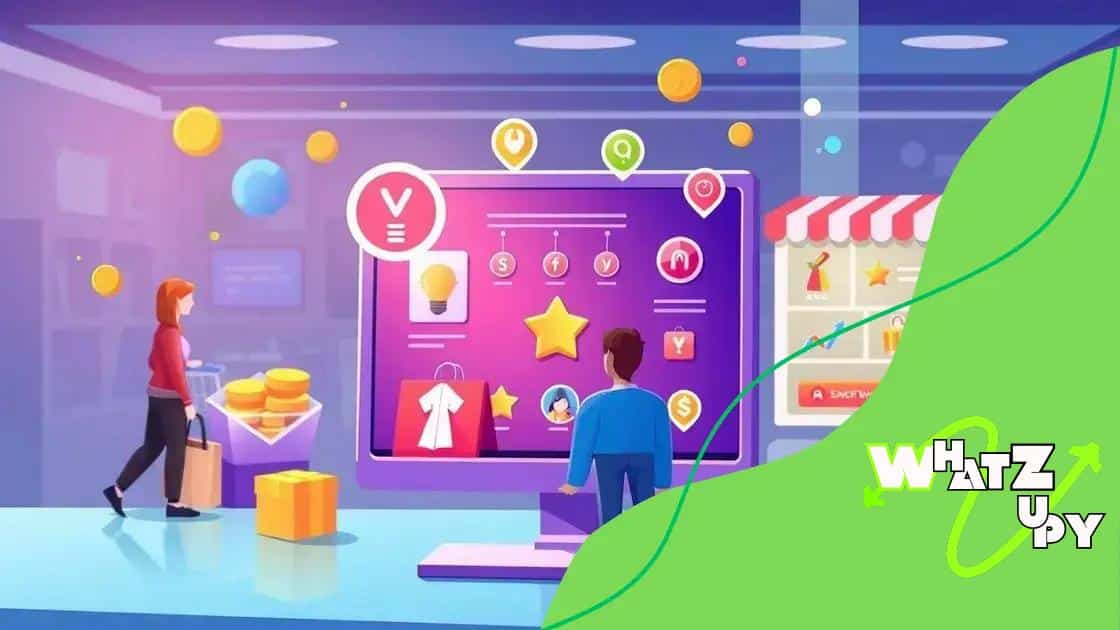Gamified ecommerce experiences for higher engagement

Gamified ecommerce experiences enhance customer engagement and loyalty by integrating game-like elements such as rewards, challenges, and user tracking to create a more interactive and enjoyable shopping environment.
Gamified ecommerce experiences are changing how customers engage with brands online. Imagine shopping while playing a game – it’s fun and keeps you coming back! Let’s dive into how you can create these experiences.
Understanding gamification in ecommerce
Understanding gamification in ecommerce is crucial for creating engaging shopping experiences. By adding game-like elements, businesses can make their online platforms more appealing to users. This approach not only attracts customers but also encourages them to interact more with the brand.
What is Gamification?
In simple terms, gamification involves applying game design principles in non-game contexts. In ecommerce, it means using features like points, badges, and challenges to motivate customers. When customers feel like they are playing a game, they are more likely to stay engaged and make purchases.
Why Use Gamification in Ecommerce?
There are several compelling reasons to implement gamification in your ecommerce strategy:
- Enhances user engagement by making shopping fun.
- Increases customer loyalty through rewards systems.
- Encourages more frequent visits and interactions.
- Provides valuable data on customer preferences and behaviors.
Gamification can also streamline the shopping experience by making it more interactive. For instance, when users complete certain tasks, they can earn rewards or discounts. This not only boosts customer satisfaction but also drives sales.
As businesses look for ways to differentiate themselves, gamification offers a unique advantage. By integrating game elements, companies can create a lively atmosphere where customers want to spend their time. The combination of fun and shopping leads to higher retention rates and boosts overall sales.
Implementing gamification in ecommerce doesn’t have to be complicated. Start by identifying key customer actions you want to encourage, such as signing up for newsletters or sharing products on social media. Then, develop a system that rewards these behaviors, turning everyday activities into fun challenges.
Benefits of gamified experiences
The benefits of gamified experiences in ecommerce are numerous and impactful. By incorporating game-like elements into your online store, you create an engaging environment that attracts customers. This approach not only enhances their shopping experience but also encourages them to spend more time on your site.
Increased Customer Engagement
One of the main advantages of gamification is its ability to boost customer engagement. When users are presented with challenges or rewards, they are more likely to interact with your content. This leads to longer visits and repeat traffic, which can significantly increase sales.
Enhanced Customer Loyalty
Gamified experiences foster customer loyalty through rewards systems. When customers earn points or achievements for their purchases, they feel valued and appreciated. This emotional connection helps businesses retain clients and encourages them to choose your store over competitors.
- Customers are more likely to return when they feel rewarded.
- Exclusive offers can be tied to gamified activities.
- Rewards encourage customers to refer friends and family.
Additionally, gamification can provide insightful data about consumer behavior. By tracking user interactions and preferences, businesses can adapt their strategies to meet customers’ needs more effectively. Gamification not only improves sales but also helps tailor marketing efforts to target specific segments.
Implementing gamified experiences does not have to be complex. Simple actions, such as adding a reward system or a points-based structure, can make a huge difference. Customers enjoy the feeling of accomplishment that comes from completing tasks and achieving milestones.
How to implement gamification strategies

Implementing gamification strategies in your ecommerce business can be an exciting way to engage customers. It starts with understanding what motivates your audience and how game mechanics can enhance their experience.
Identify Core Objectives
The first step is to identify what you want to achieve with gamification. This can include objectives such as increasing user engagement, driving sales, or improving customer loyalty. Clearly defined goals will guide your strategy and help measure success.
Understand Your Audience
Knowing your audience is crucial. Conduct surveys or analyze customer data to understand their preferences and behaviors. Are they motivated by rewards, challenges, or social interactions? Tailoring your gamification efforts to these insights will yield better results.
- Offer rewards that appeal to your target demographic.
- Create challenges that are relevant to your products.
- Incorporate social elements, like leaderboards or sharing options.
Next, you can incorporate game mechanics that fit your identified objectives. Points systems, badges, and levels are popular elements that can create a sense of progression. When customers earn points for making purchases or sharing products, they feel a sense of accomplishment.
Additionally, design challenges that encourage participation. This might include incentivizing customers to complete certain tasks, like reviewing a product or referring a friend. These challenges should be fun and easy to understand, promoting a seamless experience.
Once implemented, it’s essential to regularly review and adjust your gamification strategy. Use analytics tools to track user engagement and gather feedback. This data will help you refine your approach, ensuring it remains relevant and effective.
Examples of successful gamified ecommerce
There are several examples of successful gamified ecommerce that demonstrate how engaging elements can improve customer experience and drive sales. These businesses have effectively blended gaming mechanics with shopping, showing remarkable results.
Starbucks Rewards Program
Starbucks has a highly effective gamification system in its rewards program. Customers earn stars for every purchase, which can be redeemed for free drinks and food items. The app gamifies the buying experience by allowing users to track their stars and reach different reward levels. This motivates customers to visit more often and engage with the brand.
Nike’s Run Club
Nike has integrated its ecommerce strategy with its fitness app, Nike Run Club. Users can set running goals and earn achievements while tracking their progress. By combining a social aspect with rewards for completing challenges, Nike keeps customers engaged with their products through fitness and lifestyle.
- Users can share their achievements on social media.
- Achievements can lead to discounts on future purchases.
- Community challenges increase competition and motivation.
Another great example is Duolingo, an app focused on language learning. Duolingo uses a gamified approach by offering points, levels, and streaks as users progress in learning languages. This method keeps users coming back to improve their skills, and they often engage with language-related products and services associated with the brand.
Gamification in ecommerce isn’t limited to traditional retail. Even subscription services like Spotify use gamified elements to enhance user experiences. They create personalized playlists based on user habits and achievements, turning music discovery into a fun and engaging game.
Measuring engagement and success in gamification
Measuring engagement and success in gamification is essential to understand its impact on your ecommerce strategy. By analyzing key metrics, businesses can determine what works and what needs improvement. This helps refine gamification tactics to enhance user experience and increase sales.
Key Metrics to Track
There are several important metrics to consider when measuring engagement:
- User engagement levels: Track how often users interact with gamified elements, such as challenges and rewards.
- Conversion rates: Measure how gamification affects purchasing behavior and conversions on your site.
- Retention rates: Evaluate how well gamification keeps customers returning to your brand.
- Social sharing: Monitor how often users share their achievements on social media platforms.
Understanding these metrics gives a clearer picture of user behavior. Another effective method is conducting user surveys that gather feedback on the gamified experience. Users can provide insights on what they enjoy and what could be improved.
Using Analytics Tools
Utilizing analytics tools is vital for tracking these metrics effectively. Tools like Google Analytics can provide detailed data about user interactions with gamified features. Set up event tracking to analyze how users engage with specific game mechanics. This will also help segment your audience based on their level of interaction.
Regular analysis and adjustment based on feedback will keep your gamification strategy fresh and relevant. By staying attuned to your audience’s preferences, you can continually enhance their experience.
Lastly, compare engagement data over time to see trends and assess the overall success of your gamification strategies. Understanding how your strategies evolve will provide necessary insights to adapt to changing customer needs.
FAQ – Frequently Asked Questions about Gamified Ecommerce Experiences
What is gamification in ecommerce?
Gamification in ecommerce involves using game-like elements to enhance user engagement and motivate customers to interact with the brand.
How can I measure the success of my gamification strategies?
You can measure success by tracking key metrics such as user engagement levels, conversion rates, retention rates, and social sharing.
What are some popular examples of successful gamified ecommerce?
Examples include Starbucks Rewards, Nike Run Club, and Duolingo, all of which use gamification to engage their customers and enhance their experiences.
How do I implement gamification in my online store?
To implement gamification, identify your objectives, understand your audience, incorporate engaging game mechanics, and regularly analyze performance to make improvements.





